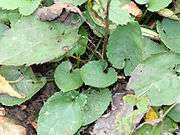Symphyotrichum cordifolium
Symphyotrichum cordifolium (formerly Aster cordifolius), commonly known as common blue wood aster,[3] blue wood-aster[4] or heartleaf aster, is a herbaceous perennial plant in the family Asteraceae native to eastern North America.
| Symphyotrichum cordifolium | |
|---|---|
 | |
| Heartleaf aster | |
| Scientific classification | |
| Kingdom: | Plantae |
| Clade: | Tracheophytes |
| Clade: | Angiosperms |
| Clade: | Eudicots |
| Clade: | Asterids |
| Order: | Asterales |
| Family: | Asteraceae |
| Genus: | Symphyotrichum |
| Species: | S. cordifolium |
| Binomial name | |
| Symphyotrichum cordifolium | |
| Synonyms[1][2][3] | |
| |
Description
Symphyotrichum cordifolium reaches heights of up to 1.2 m (3 ft 11 in). The lower leaves are heart-shaped, while leaves higher up on the stem tend to be sessile with more rounded bases. The composite flowers, which have bluish to rarely white ray florets and light yellow disc florets that eventually turn purple, emerge in August and persist into October.[5]
 Symphyotrichum cordifolium leaves
Symphyotrichum cordifolium leaves
Where its range overlaps with that of Symphyotrichum puniceum hybrids sometimes occur, which are named Symphyotrichum × tardiflorum.[5]
Distribution and habitat
Symphyotrichum cordifolium occurs from Manitoba east to Nova Scotia and Maine, south to Georgia and Alabama and west to Oklahoma. It grows primarily in mesic sites with soils that are rocky to loamy, but generally rich, at heights ranging from sea level along the coastal plain up to 1,200 m (3,900 ft) in the Appalachians. It can be found on open wooded slopes, along the banks of streams, on moist ledges, in swampy woods, along the borders of beech–maple and oak–hickory forests, as well as in clearings, thickets and along roadsides and ditches. It can also be found in urban areas where it is sometimes a weed species.[5]
Cultivation
The species is one of many species of North American asters that are cultivated as garden plants, often under the older name Aster cordifolius. Several cultivars have been selected for garden use, of which the following have achieved the Royal Horticultural Society's Award of Garden Merit:-[6]
- A. cordifolius 'Sweet lavender'[7]
- A. cordifolius 'Chieftain'[8]
- 'Little Carlow' (A. cordifolius hybrid)[9]
- ‘Photograph’ (A. cordifolius hybrid)[10]
References
- "Symphyotrichum cordifolium". NatureServe Explorer. NatureServe. Retrieved 2007-06-15.
- "Symphyotrichum cordifolium". International Plant Names Index (IPNI). Royal Botanic Gardens, Kew. Retrieved 2008-06-07.
- "Symphyotrichum cordifolium". Natural Resources Conservation Service PLANTS Database. USDA. Retrieved 6 December 2015.
- "BSBI List 2007". Botanical Society of Britain and Ireland. Archived from the original (xls) on 2015-01-25. Retrieved 2014-10-17.
- Brouillet, Luc; Semple, John C.; Allen, Geraldine A.; Chambers, Kenton L.; Sundberg, Scott D. (2006). "Symphyotrichum cordifolium". In Flora of North America Editorial Committee (ed.). Flora of North America North of Mexico (FNA). 20. New York and Oxford – via eFloras.org, Missouri Botanical Garden, St. Louis, MO & Harvard University Herbaria, Cambridge, MA.
- "AGM Plants - Ornamental" (PDF). Royal Horticultural Society. July 2017. p. 100. Retrieved 30 November 2018.
- "Aster cordifolius 'Sweet Lavender'". RHS Plant Selector. Royal Horticultural Society. Retrieved 6 June 2013.
- "Aster cordifolius 'Chieftain'". RHS Plant Selector. Royal Horticultural Society. Retrieved 6 June 2013.
- "Aster 'Little Carlow'". RHS Plant Selector. Royal Horticultural Society. Retrieved 6 June 2013.
- "RHS Plantfinder - Symphyotrichum 'Photograph'". Retrieved 30 November 2018.
![]()
![]()
